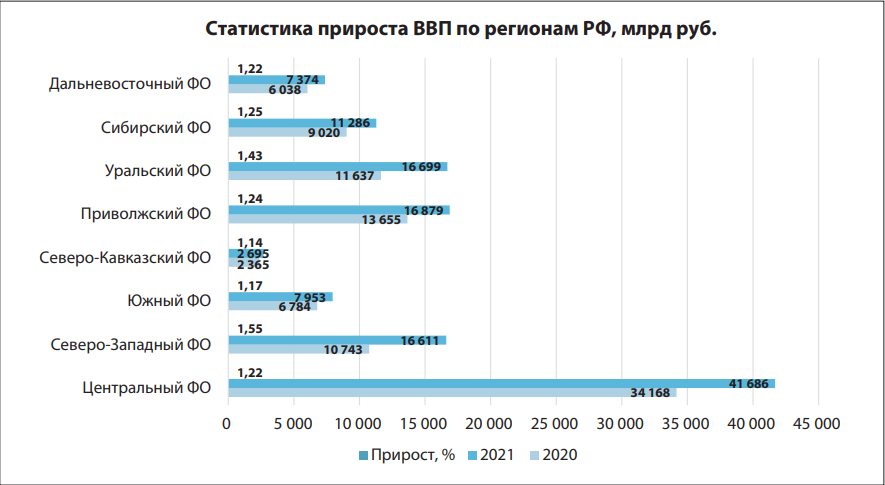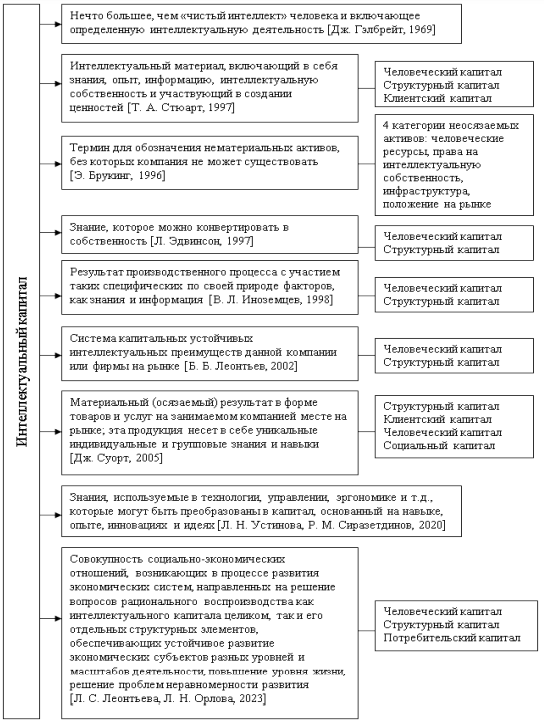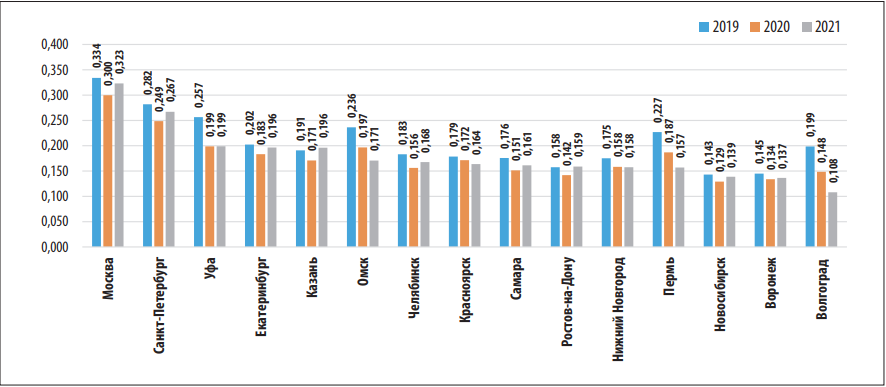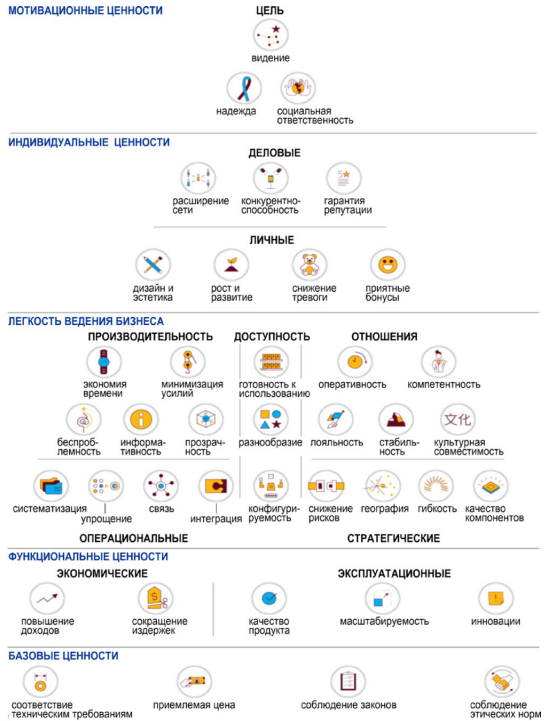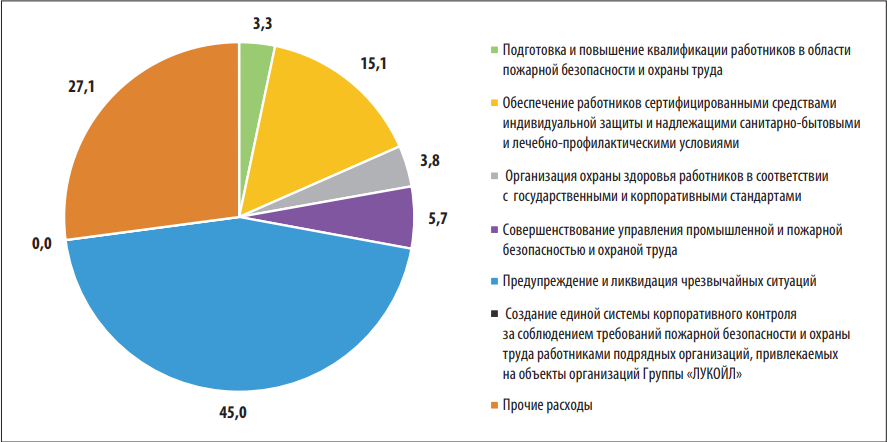ECONOMICS
A qualitative analysis of the current economic situation at the regional level is possible due to the available approaches to identifying the shadow economy’s subjects. Even if successfully applied to a specific subject, the research model can quickly lose its relevance due to technological progress, updates
to the legal framework, and changes in the general approach to managing business entities. Most enterprises combine legal and illegal ways of conducting financial activities and focus on indicative markers of a particular industry or region, which demonstrates the other cause of the reduced effectiveness of previously used calculations. The study reviews the methods of statistical monitoring of the operation of enterprises and entities that allow for detecting signs of shadow economy activity, identifying the most problematic industries in the region, and assessing the damage to its well-being. The indicators are established based on the analysis of officially published statistical data, which makes it possible to determine the proportion of enterprises engaged in shadow activity. A review of existing models will provide a correct approach suitable for the given research conditions and the identification of subjects applying tax avoidance schemes, including those using illegal workers’ labor. Successful operation of models will ensure the correct scientific approach and create the foundation for obtaining high-quality analysis findings.
Effective management of the region’s intellectual capital requires a well defined structure in which all elements are interconnected and regional characteristics are acknowledged. The study aims to develop a mechanism responsible for the intellectual capital of the region. The subject of the study is the intellectual capital of the region. To achieve the aim, the study examines various interpretations of the concept of intellectual capital, with the components of intellectual capital indicated. The influence of intellectual capital on the sustainable development of economic entities is revealed. The study identifies priority areas for supporting the development of regional intellectual capital, such as basic components and components of infrastructure capital. In the Pskov Region, a list of enterprises that form the intellectual capital of the region, which is considered a leading factor in production, is formed. The dynamics of indicators of the components of intellectual capital in the Pskov Region is presented. Theoretical and static methods for processing research data are used. The ambiguity of scientists’ views is revealed through an analysis of their approaches to the formation of the region’s intellectual capital. The authors proposed a mechanism responsible for the intellectual capital of the region in the form of a closed effective interaction of elements of the capital structure, with regional infrastructure playing a significant role. The study focuses on the need to develop innovative approaches to improving intellectual capital. The concepts of intellectual capital and intellectual capital of the region are compared. It is noted that the concept is not unambiguous, since it does not determine how many components of intellectual capital, in addition to the basic ones, should be taken into account. The ambiguity of the concept predetermined differences in the mechanisms responsible for intellectual capital. The mechanism responsible for intellectual capital proposed by the authors clearly shows the interconnection of all its elements, taking into account regional
characteristics.
The article deals with the analysis of banking risks under the transition to sustainable development (Environmental, Social, and Governance risks, ESG risks). The study examined the main Environmental, Social and Governance (ESG) factors as well as risks regarding their integration. It has been established that today in Russian practice, there is a lack of mechanisms for controlling and monitoring of such risks, thus leading to a decrease in the financial performance of a credit organization should any of these risks arise.
In this regard, at the initial stages of integrating ESG factors, it is recommended to utilize one of the methods of a simplified monitoring system: consider ESG risks in the current risks system or use ESG risk stress test tools. The study’s findings can be used to advance theoretical and empirical developments on issues related to the integration of ESG factors.
Russia lags behind developed countries in terms of small business development indicators. The role and relevance of small businesses in Russia’s economy are especially increasing under the economic instability caused by the West imposing greater pressure through sanctions in order to weaken Russia’s economy. The subject of the study is the current taxation system for small and medium-sized businesses. The study aims to assess the effectiveness of the applied special tax treatments and the changes made to them following the elimination of the single tax on imputed income. The objective of the study is to identify the advantages and disadvantages of the applied tax treatments. The study used such scientific methods as analysis, synthesis, grouping, generalization, the table method, etc. The author examines the criteria established by law for classifying enterprises as small businesses, including those that allow for the use of special tax treatments, etc., withthe actual indicators in mind. The study established that the small business taxation has issues that necessitate further improvement of the taxation system for small and medium-sized businesses
The article examines the social and economic development of territorial entities. The authors focus on the metropolitan cities of Russia, i.e., the administrative centers of the entities of the Russian Federation. The article examines the existing economic and legal literature on the problems and prospects of the social and economic development of cities. The existing limitations in the application of certain assessment methods regarding the territorial aspect are outlined. The authors have developed a methodology for multi-criteria assessment of the social and economic development level (SED index) of cities based on the assessment of key components of the social and economic development of metropolitan cities in the Russian Federation. The methodology was tested based on municipal statistics data from 83 metropolitan cities in the Russian Federation. The study covered the period from 2019 to 2021. The findings were assessed by comparing cities ‒ objects of the study, grouped by population size. The analysis demonstrated differentiation in the level of development of metropolitan cities, with the highest dispersion of values observed in the group of big cities with populations ranging from 250 thousand to one million people. Furthermore, the study found the general downward trend in the dynamics of the level of social and economic development of metropolitan cities in the Russian Federation over the studied period. The proposed methodology can be used to conduct studies of the social and economic development of territorial entities, monitor the level of social and economic development of cities, and make effective management decisions to reduce the excessive distance between city development levels.
The digital acceleration caused by the pandemic has increased the interest of companies worldwide in B2B. The study aims to examine the key aspects and features of B2B marketing, as well as the current prospects for its use. The article studies the marketing managers’ scientific works; considers elements
of the B2B value pyramid and a marketing approach to meeting customer needs; analyzes B2B technologies for developing new marketing strategies and methods for selling goods and services. The novelty of the study lies in expanding the understanding of effective B2B marketing interactions through the lens of the value approach. The study confirms that certain marketing attributes used by B2B companies might significantly affect customers’ purchasing decisions in their favor. Customer behavior is not always rational and requires a value based approach to understand marketing communications. B2B companies involve different types of activities, which requires further research. B2B e-commerce offers great opportunities for organizations and will continue to play an important role in the global economy and trade in the future.
The article examines how investment in health capital affects labor productivity using the example of a specific enterprise. The authors analyzed a case study of a corporate program to prevent injuries at an enterprise, studied the basis of the health capital theory, and developed strategies to increase health capital and labor productivity. The author’s approach is unique because of the case study analysis, which provides a more detailed study of a specific case in practice. The findings of the study show that investing in the health
capital of an enterprise’s employees can significantly increase labor productivity, reduce illness and injury rates, and improve employee-employer relations. The authors’ conclusions confirm the need to invest in health capital as a means of enhancing labor productivity in an enterprise. Other companies can adopt the developed strategies to improve working conditions and an employee’s well-being.
LAW
The article presents relevant issues of the legal provision of public safety, with the developed and implemented crime prevention measures considered. The main directions for ensuring the security and sustainable development of modern society are to be determined according to the implemented international, interstate, and national policies. Measures of ensuring complex safety aimed at anti-terrorism and extremism actions and the prevention of illicit drugs and other psychotropic substance trafficking are in focus. New challenges and threats posed by globalization significantly complicate the process of ensuring the safety of socially significant facilities and crowded places. Updating legal measures to achieve the goals of strategic planning for ensuring public safety is becoming trending.
The article analyzes the regulatory requirements for indicating the territorial area in the legal naming of public associations in the Russian Federation and the practice of their application. The study is based on the analysis of regulatory legal acts that define the requirements for the name of public associations, as well as a comparison of the responses of territorial divisions of the Ministry of Justice of the Russian Federation to requests for interpretation of these requirements. The authors explore various approaches to the interpretation of legislation on the need to include an indication of the territorial area in the name of public associations. The findings of a survey of territorial departments of the Ministry of Justice of the Russian Federation demonstrate ambiguity in the understanding and application of the relevant legal requirements. The article examines the possible consequences of different approaches to indicating territorial affiliation for legal certainty and protection of the naming rights of public associations. In conclusion, recommendations are proposed for unifying the practice of applying regulatory requirements, aimed at eliminating legal uncertainty and ensuring the protection of the rights of public associations to their unique name in accordance with constitutional principles.
The article discusses the legal nature of associations of territorial public self-government and summarizes the practice of their organization and activity; examines the interaction of associations, public authorities, and local self-government authorities regarding the federal districts; identifies regional features of the establishment and activity of territorial public self-government associations; studies and considers legal acts regulating the activities of associations and their statutory documents, as well as directions and types of associations’ activities; and studies the court practice on disputes with associations. Territorial public self-govern ment associations play an important role in consolidating regional and local communities and involving them in solving problems of territorial development. The activities of regional territorial public self-government associations are systematized. The general approaches of territorial public self-government associations to the issues of community involvement in solving territorial development problems are presented, some of which can be used in model legal acts.
The establishment of urban agglomerations, or large-scale complex territorial units, is one of the global trends. In modern democratic states, the practice of managing urban agglomerations successfully applies mechanisms of inter-municipal cooperation as the primary means of cooperation between municipalities. At the same time, he Russian Federation’s inter-municipal cooperation institution is underdeveloped, preventing municipalities from working together to solve local challenges by transferring powers and resources between municipalities of the urban agglomerations. In this regard, the article examines the prospects for the development of legal regulation of special forms of inter-municipal cooperation in urban agglomerations, which is distinguished by the transfer of powers to resolve local issues between municipalities within the agglomeration.
The author analyzes statistical data on the main social and demographic features as well as some criminal and legal features (regarding the penalty) of convicts under Article 264, Parts 4 and 6 of the Criminal Code of the Russian Federation (traffic offenses and operation of vehicles leading to manslaughter by negligence) from 2015 to 2022 (no data available for 2023). The data were obtained from the Judicial Department of the Supreme Court of the Russian Federation. Based on the findings, theoretical provisions that supplement and renew the scientific knowledge of the identity of a convict who committed a crime under Article 264, Parts 4 and 6 of the Criminal Code of the Russian Federation are established. The author analyzed statistical data on the main social and demographic features as well as some criminal and legal features (regarding the penalty) of convicts under Article 264, Parts 4 and 6 of the Criminal Code of the Russian Federation. The analysis allowed for renewing the criminological profile of a convict who committed a crime, such as a traffic offense and operation of a vehicle. The author conducted a comparative analysis of such convicts according to the data obtained in the earlier research published in June 2020 and new data, covering the issue of choosing a penalty for convicts as well.
An approach to reporting terrorist crimes can be improved with the content and nature of cognitive errors at hand. Understanding cognitive biases in the perception of reality will also help monitor the statistics of these crimes. The need to dwell on the impartiality and consistency of information about crimes committed has been identified through the analysis of society’s perception of terrorist threats. The idea to evaluate the psychology of cognition in relation to terrorist threats appeared due to violations of objective reality, provoked by the peculiarities of broadcasting data on crimes committed, the constructive properties of normative prohibitions, and the assessment of open statistical data. The purpose of the study is the need to provide undistorted, unbiased data on terrorist crimes in society.


